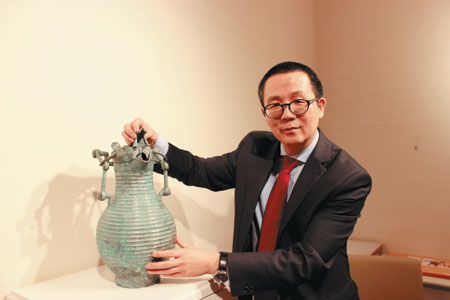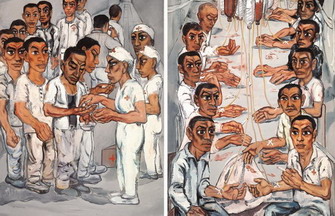New Bronze age
By Liu Lian ( China Daily ) Updated: 2014-02-27 07:31:20
|
Wang Tao, head of Chinese Works of Art at Sotheby's, shows the Chinese bronze owl-headed ritual wine vessel that will be auctioned at Sotheby's on March 18. Provided to China Daily |
| Controversial piece has art world in a flap |
|
 |
| Sotheby's makes its biggest ever London art sale |
A very rare Chinese bronze owl-headed ritual wine vessel dating to the Eastern Zhou Dynasty (771-221 BC) will be auctioned at Sotheby's on March 18.
The New York auction house acquired the ancient bronze piece one week ago from Sakamoto Goro, a well-known Japanese antiques dealer.
The 46-centimeter-high bronze vessel is pear-shaped and encircled by 30 horizontal grooves. Though tarnished by time, the design is clear and intact. The cover of the vessel was carved in the form of an owl's head with a beak as the spout. Inside the cover there are inscriptions of nine characters. The piece is believed to have been produced and excavated in Shangdong province.
Animal motifs were widely used in early Chinese art, showing significant cultural influence of the Northern Steppes, says Jason Sun, curator of the Asian Art department at the Metropolitan Museum of Art.
"The symbol of the owl has its roots in ancient mysteries, but it's also a symbol in reverence to ancestors," says Wang Tao, head of Chinese Works of Art at Sotheby's. "A hu is a vertical container for liquid. The wine vessel is, therefore, not only an achievement in the decorative details, but also functional and practical."
The provenance of the bronze vessel was traced back to the late 19th century, and has been well documented and studied since by Chinese and Western scholars. The first recorded collector was a Chinese scholar named Wu Yun (1811-1883). In a letter, Wu says the vessel was first found in a metal recycling store in Shanghai in 1861 and sold to a friend of his from whom he acquired the piece in an exchange.
Taken to Europe in the 1930s, its first recorded sale in the West took place in 1945 for 1,134 pounds, a formidable amount at the time. Guiseppe Eskenazi, a distinguished London-based dealer, sold it to the British Rail Pension Fund in 1978 for 120,000 pounds. Sotheby's London held the last auction of the bronze piece in 1989, when the current owner Sakamoto Goro bid more than 480,000 pounds ($800,000) - four times its sale estimate.
Chinese bronze pieces have interested Chinese over millenniums because they are regarded as one of the most ancient arts, if not the only art that was created at the time, says Henry Howard-Sneyd, Sotheby's vice-chairman of Asian art.
"Created in a very durable material, they were able to survive to the present day and in many cases in remarkable conditions," he says.
- Art summit focuses on big picture
- Christie's holds inaugural auction
- Sotheby's charity auction fetches $2.5 million
- Top 10 Chinese art works sold at auctions for 2013
- Top 10 Chinese painters and western artists
- London art market buzzing after Christie's contemporary art sale
- Top 10 lots at Christie's 2013 sale
|
|
|
|
|
|
|
|
























 Raymond Zhou:
Raymond Zhou: Pauline D Loh:
Pauline D Loh: Hot Pot
Hot Pot Eco China
Eco China China Dream
China Dream China Face
China Face





